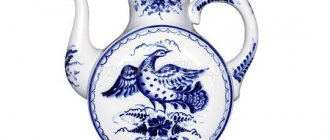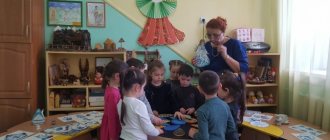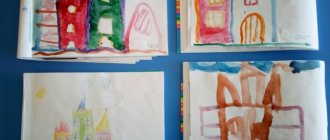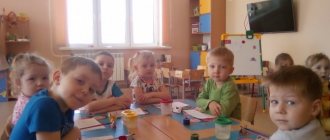Program content: To introduce children to Gzhel porcelain, its characteristic features: the shape of the products, their purpose and patterned design in content, color, composition
To expand children’s knowledge about artistic crafts, to cultivate love and respect for folk traditions in art and its masters.
Progress of the lesson
An exhibition of Gzhel dishes is organized in the hall: samovars with teapots, a sugar bowl, an oil dish, a vase, a lion milkman, a cat sculpture
Book by N. Suryaninova “Blue Flowers of Gzhel”, postcards, illustrations. Badges for each child with a picture of a Gzhel rose on a circle.
Teacher's story:
— We came to an exhibition of dishes decorated with blue painting, they call it “Gzhel”. Based on the name of a small village near Moscow. Porcelain products are created in factories there. And these products are so good, people loved them so much that the fame of Gzhel masters spread not only throughout the country, but also far beyond its borders.
I like Gzhel primarily for its blue color. The Gzhel people themselves say that their sky is blue, blue. So they decided to transfer this blue to white porcelain.
Each artist comes up with his own vases, oil dishes, teapots, milk jugs, and sugar bowls. There are so many artists, so many different forms. And they are always unusual - cheerful, beautiful.
(They look at a samovar, a flower vase).
-Every thing made in Gzhel is interesting to look at and admire. Admire it too. Gzhel masters are great dreamers. Some cups are slender and tall, others look like a small barrel, and other figures are intricate. And everyone’s hands are different. When you see Gzhel teapots, your eyes widen. They are very good!
Look at this lion, he is not afraid of anyone, he is even a little funny, his mane is like a rose!
The artist’s hand moves a brush with paint along the white background of the cup, pressing it harder and weaker. And everything he draws becomes blue and blue - both flowers and grass. Just one paint, and what an elegant and festive painting it turns out to be!
The border is placed along the edges. (Suggests considering a samovar, sugar bowl).
-The most favorite pattern is the Gzhel rose. Sometimes it is depicted large, with broad strokes (shows on small and large teapots), and sometimes it is painted with a thin brush.
And it also happens: there is no rose itself, but only its petals (they examine).
The teacher invites the children to look at the products again, paying attention to the shapes and patterns. Gives children the opportunity to share their experiences.
Questions:
1.What elements of the pattern are used by Gzhel artists to decorate dishes.
2.What did you like most about the exhibition?
In memory of the exhibition, the teacher gives the children badges (circles with a diameter of 5 cm on which she drew different flowers).
The history of the emergence of Gzhel patterns and ornaments
The word "Gzhel" is the geographical name of several villages 60 km from Moscow, which are associated with easily recognizable white porcelain with blue painting. Gzhel is also associated with the emergence of porcelain itself in Russia, the unique recipe of which D. Vinogradov created specifically on white Gzhel clay. And no less interesting is the history of the patterns and ornaments of Gzhel themselves, so light and laconic, unlike other elements of folk crafts.
For a long time, Gzhel masters were looking for new color solutions, and the familiar white and blue format appeared relatively recently - in the middle of the nineteenth century. Before that, majolica dishes with brightly colored paintings were in high demand. White and blue solutions are a fashion that has come since the times of Peter the Great, and this is due to the painted faience brought from Holland. The foreign idea formed the basis of the Russian craft. It must be said that the Dutch themselves once borrowed blue and white patterns from the Chinese.
Delft faience (Holland)
Gzhel was called “Russian Stafforshire”, but the Gzhel patterns were distinguished by a special message, which was conveyed both in the technique, and in the choice of Gzhel elements, and in their combination. Blue sky, white churches, golden domes - these are elements of Gzhel painting that have become a reflection of the Russian mentality. And they became one of the most recognizable brands of Russian folk culture.
Color scheme of Gzhel painting
Traditionally, the design is done only in shades of blue. Against the background white color of porcelain, the master is able to convey the entire palette of the universe with one color. But blue can be different: from faded blue to expressive deep blue, turning into shades of night. A dark cobalt color is also used. And the laconic Gzhel pattern is completed with platinum or gold decor.
And before that, Gzhel popular print was popular, when the craftsmen painted the dishes with blue, yellow, brown and purple paints, all on the same white background. But the most beautiful handicrafts are considered to be overglaze samples: the craftsman applied colored paints directly over the glaze. After this, dishes or other products must undergo three or even four firings.
Progress of the lesson
The teacher reminds that winter is coming to an end, suggests remembering the colors in which the children painted winter landscapes , thinking about what colors are most suitable for Winter, what kind of dishes she might like. Draws attention to the stand with products of Gzhel craftsmen.
Questions: - What is the name of the painting that decorates all these products? - How did you guess that it was Gzhel?
-What colors are characteristic of Gzhel painting?
— What elements of painting do you know? Name them.
-What material is Gzhel tableware made of?
— Name the familiar items of Gzhel dishes and their purpose.
-What color is the background of Gzhel dishes?
— What is the favorite element of Gzhel craftswomen?
How do Gzhel craftsmen make their dishes?
— Why is it called Gzhel? How are all the dishes decorated? ( Flowers , leaves, birds, twigs.)
The teacher clarifies that Gzhel dishes are painted with blue paint of different shades on a white background and, in their color scheme, are very suitable for winter flavor . Invites children to decorate dishes for Zimushka-winter. Reminds me that unusual blue-blue flowers on dishes will delight Zimushka, because any girl likes flowers .
Shows a new element of painting - the Gzhel rose, the most favorite flower of the craftswomen of this craft. Shows children examples of how to perform this element and reminds them of the sequence of drawing andvetka .
— The basis of the image of a Gzhel rose is a brushstroke with a shadow. This is a special tonal stroke in which the transition from dark to light shades of blue is clearly visible . To obtain a good stroke, it is very important to correctly distribute the paint on the brush - there should be no more paint towards the edge, and less towards the middle. (Shows and comments on the process of making a Gzhel rose.)
Children's master class on drawing in an unconventional technique “Winter patterns” Materials for completing the master class: blue paper, a simple pencil, PVA glue, semolina (expired, past the expiration date. Lesson on the application “Flowers” Program tasks: improve the work with scissors - cut the paper into narrow strips, cut circles from squares; exercise the skill. Notes on non-traditional drawing "Flowers" Objectives: expand children's knowledge about flowers, their diversity; teach children to draw flowers using unconventional drawing techniques; develop. Notes NOD for drawing “Winter Sports” in the preparatory group On FEBRUARY 4 in Sochi, the All-Russian Day of Winter Sports was celebrated, dedicated to the third anniversary of the opening of the Olympic Winter Games 2014. Summary of a lesson in drawing in mixed media “Winter Trees” Objectives: to develop children’s cognitive interest, cultivate an aesthetic perception of the winter landscape; enrich vocabulary; teach children to draw.
Speech therapy lesson in a school-preparatory group for children with STD on the lexical and grammatical topic “Winter fun” Speech therapy lesson “Winter fun” in a school-preparatory group for children with STD (OND) on the lexical and grammatical topic “Winter”. Target:.
Project lesson “Children are the flowers of life” Objectives: Involve children and parents in creative activities, during which, thanks to communication and cooperation, they will become closer. "Winter fun" Lesson-walk in the senior group Progress of the walk: Children go out to the site with a teacher. 1. Observation of the bushes. The teacher and the children approach the bushes: Which one. Drawing lesson “Flowers as a gift for mom” Drawing lesson with gouache paints “Flowers as a gift for mom” in the middle group. Goal: To create a desire to draw as a gift for mom on March 8th. Lesson on drawing from life in the senior preparatory group “Flowers in a vase” Lesson on drawing from life in the senior preparatory group on the topic: “Flowers in a vase” Educator: Panova Irina Sergeevna Quantity.
Source
Abstract of the educational activity “Travel to Gzhel”
Legun Irina
Abstract of the educational activity “Travel to Gzhel”
SUMMARY OF NOD “ TRAVEL TO GZHEL ”
(integration of educational areas: “Cognitive development”
+
“Speech development”
+
“Artistic and aesthetic development”
using ICT)
Goal: To expand preschoolers’ understanding of objects of the man-made world in the system of work to familiarize themselves with folk art
Learn to highlight the traditional features of Gzhel painting : white background and blue-blue pattern
Deepen children's knowledge about folk artists and the unique Gzhel culture
Learn to recognize the quality and properties of objects
Learn how to apply strokes (paint)
on the product, create expressive patterns on paper and on three-dimensional objects
Develop children’s ability to listen to each other and communicate freely in small groups
Develop cognitive activity and interest in objects of the man-made world
Intensify children's attention to studying and identifying the characteristics of the cultural heritage of their people, their country
Develop skills in a creative approach to doing work
Foster a love for the origins of native culture
To cultivate a sense of form, color, symmetry, admiring the richness and true beauty of the man-made world,
Foster a desire to help loved ones, empathize, care and maintain the harmony of nature
Preliminary work: examining Gzhel , drawing, stories about folk craftsmen, reading fiction, plaster modeling, visiting and creating a mini museum.
«Travel to Gzhel»
Motifs and elements
Depiction of rural life in Gzhel
The theme of the painting is a reflection of the master’s worldview, traditional and cultural understanding of life, its course and main events. Artists can turn to iconographic elements; they capture scenes of everyday life and observations of the natural world.
The subject of the drawing is differentiated into 4 types:
- subject drawing – involves displaying the seasons, landscapes;
- ornamental - these are the usual mesh combs, pearls, as well as tendrils, droplets, layers and checkers;
- plant motifs - berries, buds, grass, branches and cereals;
- animals are usually birds.
Natural motifs and architecture today can often be found on tea sets and other Gzhel tableware. To this day, the masters depict peasant buildings, wide city streets, and churches on their products. Floral designs are also popular: take the same Gzhel rose, which migrated from porcelain to prints on clothes, etc.







